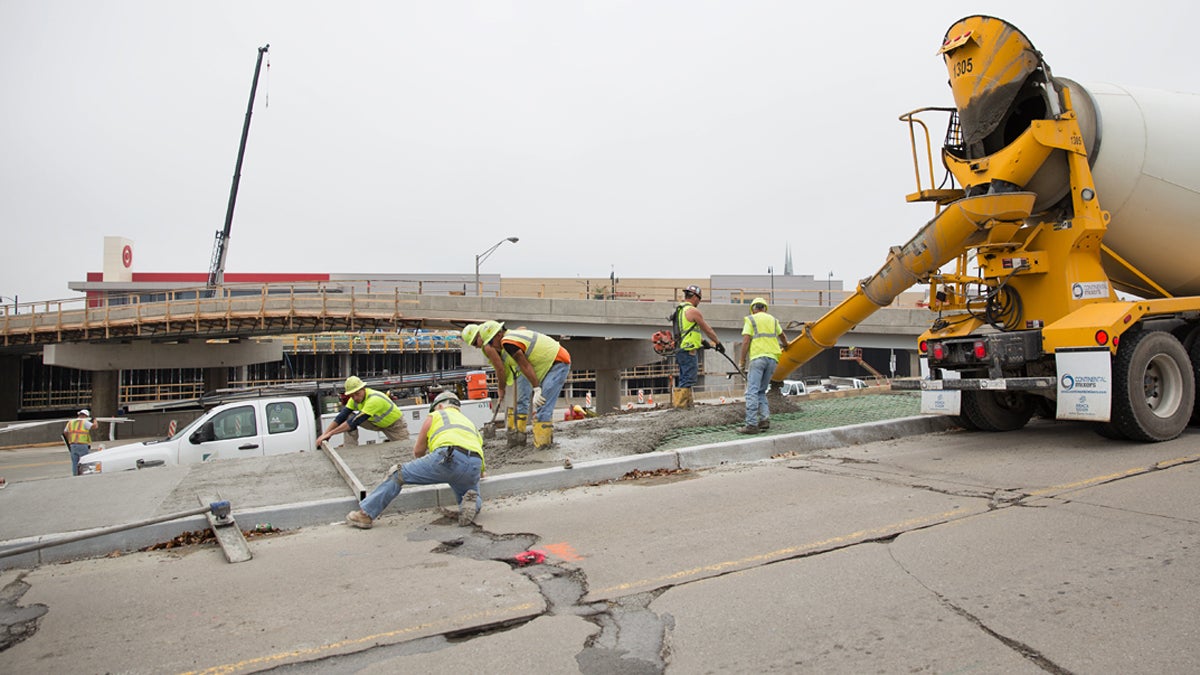Transit oriented development is seen as the cure for the commute: but what makes it fail or succeed?

Construction workers pour concrete near the East Liberty transit station in Pittsburgh, Pa. (Lindsay Lazarski/WHYY)
Urban planners have started to design for transit oriented development. Certain factors can contribute to the success of a project.
Train stations, bus terminals, and other transportation hubs throughout Pennsylvania have varying degrees of development around them. Since the turn of the century urban planners in Pennsylvania cities, as well as other U.S. metropolises, have started to once again think and design for transit oriented development, with many transit projects incorporating larger development plans beyond basic infrastructure. Transit oriented development is broadly defined as a station or transport hub surrounded by a dense, mixed use, walkable neighborhood. The idea is to cut down on peoples’ commuting time (and thus congestion, pollution and other societal byproducts of long commutes) and plan for future urban growth.
Transit oriented development can take many forms. For example, Jefferson station, formerly Market East Station, in Philadelphia doubles as a retail center and has integrated connections to other transit, but it sits apart from residential areas. In Pittsburgh’s East Liberty neighborhood, ongoing expansive development around bus routes deliberately includes residential units. Many other stations around the state lack development altogether; they look like the kind of abandoned dark places your mother has told you repeatedly to stay away from. Why is there such a difference?
A new Government Accountability Office study found a few factors that can affect whether a station grows beyond its barebones function as a place to board a train. The study found the factors that are associated with successful transit oriented development are:
market demand for real estate, which implies a strong local economy
large parcels of land available for development
resident support for transit and transit oriented development
But there are also challenges to creating transit oriented development, according to the GAO report:
construction costs can be higher for mixed use development than traditional single-use development
lenders may be reluctant to finance transit-oriented development because of perceived higher risk
local approval processes can be burdensome
local residents may not support transit or dense development
physical features surrounding a transit station may be undesirable for development
land parcels could require significant time or investment before they are usable
Local government can also up the chances of development success:
create zoning and regulations that support transit-oriented development
develop neighborhood-scale land use plans
respond to local residents’ preferences
respond to market demand
invest in infrastructure that works with transit oriented development, like multimodal connections
provide tax credits for developers
Why should we care if transit oriented development happens? The Federal Transit Administration lists benefits of transit oriented development as increased ridership, vitalization of neighborhoods, increases in the supply of affordable housing, and increased revenue for nearby businesses. It also lists some secondary benefits like congestion relief, land conservation, and improved safety for pedestrians and cyclists. But there’s also this to consider: young people are moving to cities and they’re driving less. They want the amenities of dense urban living and carless options for getting around their cities. Transit oriented development provides both. That’s something cities like Pittsburgh, which is working hard to attract new residents but has a complex car-focused infrastructure to contend with, will have to keep in mind.
WHYY is your source for fact-based, in-depth journalism and information. As a nonprofit organization, we rely on financial support from readers like you. Please give today.


